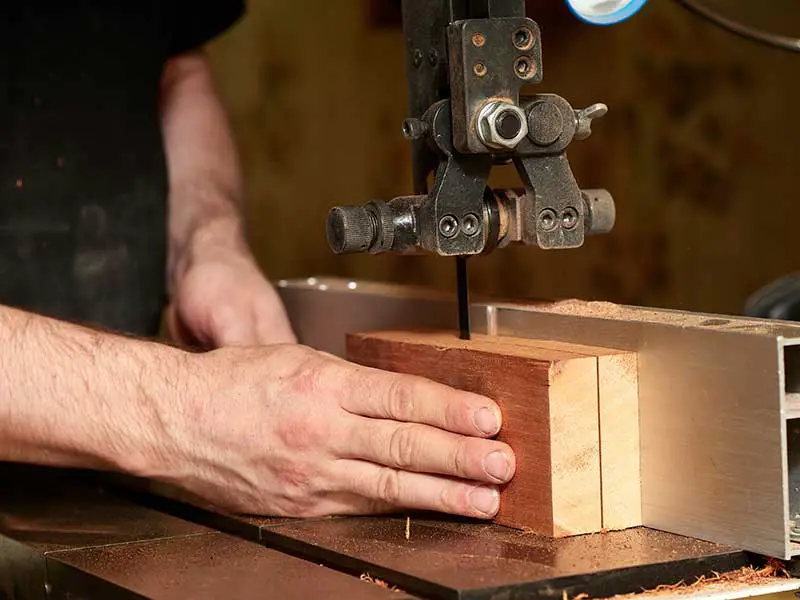A band saw works by using a continuous loop of serrated blade, driven by two wheels, to make precise cuts in various materials. The user feeds the material into the moving blade, while blade guides support the blade for accurate cutting.

A band saw is an essential power tool for any workshop, known for its versatility and ability to make intricate cuts. In this comprehensive guide, we’ll dive into the mechanics of a band saw, its components, how to use it safely, and tips for maintaining its performance. With at least 1500 words, this article aims to provide a deep understanding of band saws and their operation.
Introduction to Band Saws
Band saws are designed to make precise cuts in various materials, such as wood, metal, and plastic. With a continuous loop of serrated blade mounted on two wheels, a band saw can make straight, curved, and even irregular cuts with ease.
Components of a Band Saw
Frame
The frame is the main structure of the band saw, providing support and stability for all other components. It is typically made of cast iron, steel, or aluminum to ensure durability and resist vibration during operation.
Wheels
A band saw has two wheels – an upper and a lower wheel. These wheels drive the blade and maintain its tension. They are usually covered with rubber or urethane tires to protect the blade and minimize slippage.
Blade
The blade is a continuous loop of serrated metal that wraps around the wheels. Different blade widths, tooth styles, and tooth counts are available to suit various cutting applications and materials.
Blade Guides
Blade guides support the blade and minimize deflection during cutting. They consist of an upper guide assembly mounted below the top wheel and a lower guide assembly near the bottom wheel.
Table
The table provides a flat, stable surface for material support during cutting. It usually features a miter slot and can be tilted for making angled cuts.
Fence
The fence is an adjustable guide that helps maintain straight cuts by providing a reference edge for the material.
How a Band Saw Works: The Cutting Process
- Powering the Band Saw: When the band saw is turned on, the motor drives the lower wheel, which in turn drives the upper wheel through the blade. This motion creates a continuous loop, causing the blade to rotate at a high speed.
- Feeding the Material: As the blade moves, the user guides the material along the table and into the blade. The teeth of the blade cut into the material, removing small chips and creating the desired cut.
- Blade Guides: The upper and lower blade guides support the blade during cutting, minimizing deflection and improving accuracy.
- Dust Collection: A dust collection system or shop vacuum can be connected to the band saw to remove sawdust and debris, keeping the workspace clean and maintaining visibility.
Tips for Using a Band Saw Safely and Effectively
- Wear Protective Gear: Always wear safety goggles, hearing protection, and a dust mask while operating a band saw.
- Maintain a Safe Distance: Keep your hands at least 3 inches away from the blade during cutting, and use push sticks or other safety devices when necessary.
- Maintain Blade Sharpness: A sharp blade is essential for accurate and efficient cutting. Regularly inspect and sharpen your blade or replace it when needed.
- Secure the Material: Make sure the material is securely positioned on the table before starting the cut.
- Never Force the Cut: Apply gentle, even pressure when feeding the material into the blade. Forcing the cut can cause the blade to deflect or break.
- Turn Off the Band Saw: Always turn off the band saw and wait for the blade to come to a complete stop before making adjustments or removing material.
| Component | Function | Maintenance Tips |
|---|---|---|
| Frame | Provides support and stability | Clean regularly |
| Wheels | Drive and tension the blade | Inspect and replace tires if necessary |
| Blade | Makes the cut | Sharpen or replace when needed |
| Blade Guides | Support and minimize blade deflection | Adjust and lubricate regularly |
| Table | Supports material during cutting | Keep clean and smooth |
| Fence | Helps maintain straight cuts | Ensure it is square to the table |
Troubleshooting Common Band Saw Issues
- Inaccurate Cuts: Ensure the blade is sharp, the blade guides are correctly adjusted, and the fence is square to the table.
- Blade Drift: Check the blade tension, alignment of the blade guides, and condition of the tires.
- Excessive Vibration: Inspect the wheels for proper alignment and balance. Tighten any loose components and make sure the band saw is securely mounted to a stable surface.
- Difficulty Feeding Material: Ensure the blade is sharp and properly tensioned, and the table is clean and smooth.
- Excessive Noise: Check for loose components, worn tires, or damaged blade guides.
